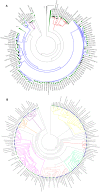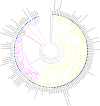Distribution and Classification of Serine β-Lactamases in Brazilian Hospital Sewage and Other Environmental Metagenomes Deposited in Public Databases
- PMID: 27895627
- PMCID: PMC5108929
- DOI: 10.3389/fmicb.2016.01790
Distribution and Classification of Serine β-Lactamases in Brazilian Hospital Sewage and Other Environmental Metagenomes Deposited in Public Databases
Abstract
β-lactam is the most used antibiotic class in the clinical area and it acts on blocking the bacteria cell wall synthesis, causing cell death. However, some bacteria have evolved resistance to these antibiotics mainly due the production of enzymes known as β-lactamases. Hospital sewage is an important source of dispersion of multidrug-resistant bacteria in rivers and oceans. In this work, we used next-generation DNA sequencing to explore the diversity and dissemination of serine β-lactamases in two hospital sewage from Rio de Janeiro, Brazil (South Zone, SZ and North Zone, NZ), presenting different profiles, and to compare them with public environmental data available. Also, we propose a Hidden-Markov-Model approach to screen potential serine β-lactamases genes (in public environments samples and generated hospital sewage data), exploring its evolutionary relationships. Due to the high variability in β-lactamases, we used a position-specific scoring matrix search method (RPS-BLAST) against conserved domain database profiles (CDD, Pfam, and COG) followed by visual inspection to detect conserved motifs, to increase the reliability of the results and remove possible false positives. We were able to identify novel β-lactamases from Brazilian hospital sewage and to estimate relative abundance of its types. The highest relative abundance found in SZ was the Class A (50%), while Class D is predominant in NZ (55%). CfxA (65%) and ACC (47%) types were the most abundant genes detected in SZ, while in NZ the most frequent were OXA-10 (32%), CfxA (28%), ACC (21%), CEPA (20%), and FOX (19%). Phylogenetic analysis revealed β-lactamases from Brazilian hospital sewage grouped in the same clade and close to sequences belonging to Firmicutes and Bacteroidetes groups, but distant from potential β-lactamases screened from public environmental data, that grouped closer to β-lactamases of Proteobacteria. Our results demonstrated that HMM-based approach identified homologs of serine β-lactamases, indicating the specificity and high sensitivity of this approach in large datasets, contributing for the identification and classification of a large number of homologous genes, comprising possible new ones. Phylogenetic analysis revealed the potential reservoir of β-lactam resistance genes in the environment, contributing to understanding the evolution and dissemination of these genes.
Keywords: Hidden-Markov-Model; hospital sewage; metagenome; phylogenetic diversity; serine β-lactamases.
Figures








Similar articles
-
Sewage effluent from an Indian hospital harbors novel carbapenemases and integron-borne antibiotic resistance genes.Microbiome. 2019 Jun 27;7(1):97. doi: 10.1186/s40168-019-0710-x. Microbiome. 2019. PMID: 31248462 Free PMC article.
-
Comparative Metagenomics and Network Analyses Provide Novel Insights Into the Scope and Distribution of β-Lactamase Homologs in the Environment.Front Microbiol. 2019 Feb 11;10:146. doi: 10.3389/fmicb.2019.00146. eCollection 2019. Front Microbiol. 2019. PMID: 30804916 Free PMC article.
-
Identification of 76 novel B1 metallo-β-lactamases through large-scale screening of genomic and metagenomic data.Microbiome. 2017 Oct 12;5(1):134. doi: 10.1186/s40168-017-0353-8. Microbiome. 2017. PMID: 29020980 Free PMC article.
-
A Structure-Based Classification of Class A β-Lactamases, a Broadly Diverse Family of Enzymes.Clin Microbiol Rev. 2016 Jan;29(1):29-57. doi: 10.1128/CMR.00019-15. Clin Microbiol Rev. 2016. PMID: 26511485 Free PMC article. Review.
-
[MULTIRESISTANT BACTERIA].Acta Med Croatica. 2015 Sep;69(3):211-6. Acta Med Croatica. 2015. PMID: 29077379 Review. Croatian.
Cited by
-
The Resistome of Low-Impacted Marine Environments Is Composed by Distant Metallo-β-Lactamases Homologs.Front Microbiol. 2018 Apr 5;9:677. doi: 10.3389/fmicb.2018.00677. eCollection 2018. Front Microbiol. 2018. PMID: 29675014 Free PMC article.
-
Core of the saliva microbiome: an analysis of the MG-RAST data.BMC Oral Health. 2021 Jul 16;21(1):351. doi: 10.1186/s12903-021-01719-5. BMC Oral Health. 2021. PMID: 34271900 Free PMC article.
-
Probing the Mechanism of Inactivation of the FOX-4 Cephamycinase by Avibactam.Antimicrob Agents Chemother. 2018 Apr 26;62(5):e02371-17. doi: 10.1128/AAC.02371-17. Print 2018 May. Antimicrob Agents Chemother. 2018. PMID: 29439972 Free PMC article.
-
Ps19, a novel chitin binding protein from Pteria sterna capable to mineralize aragonite plates in vitro.PLoS One. 2020 Mar 19;15(3):e0230431. doi: 10.1371/journal.pone.0230431. eCollection 2020. PLoS One. 2020. PMID: 32191756 Free PMC article.
-
Characterization of the First OXA-10 Natural Variant with Increased Carbapenemase Activity.Antimicrob Agents Chemother. 2018 Dec 21;63(1):e01817-18. doi: 10.1128/AAC.01817-18. Print 2019 Jan. Antimicrob Agents Chemother. 2018. PMID: 30397053 Free PMC article.
References
-
- Aubert D., Girlich D., Naas T., Nagarajan S., Nordmann P. (2004). Functional and structural characterization of the genetic environment of an extended-spectrum β-lactamase bla (VEB) gene from a Pseudomonas aeruginosa isolate obtained in India. Antimicrob. Agents Chemother. 48 3284–3290. 10.1128/AAC.48.9.3284-3290.2004 - DOI - PMC - PubMed
LinkOut - more resources
Full Text Sources
Other Literature Sources
Research Materials

